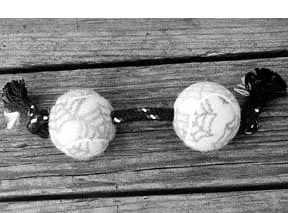The Buster Cube
Your dog needs to be mentally stimulated,” claim the makers of the Buster Cube, so they produced a product that purports to do just that. The result is a blue, hollow, hard plastic cube with rounded corners, designed to resemble a large die, even down to the spots on each of its six sides. The one-spot is actually a hole that you can pour kibble into, so that it fills the interior of the double-walled cube. When the dog pushes the Cube around, bits of food fall out of the hole. The theory is that problem behavior can diminish or even disappear entirely if a dog is given mentally stimulating tasks.
The theory is valid; dogs who are kept mentally active through basic training classes and more advanced problem-solving challenges are almost invariably better behaved than their bored and frustrated canine brethren, even those who are given ample physical exercise. (See “Getting Beyond the Basics,” this issue) But we found the Buster Cube to be a creative but unfortunately largely unsuccessful approach to accomplishing this purpose.

Our dog training consultant tested it on several dogs of varying sizes and temperaments, and found, for starters, getting the dogs to use the Cube was nowhere near as easy as the product literature claims it to be.
“All you have to do is start the game by offering the Cube and your dog will do the rest,” the pamphlet enclosed with the Cube promises. This wasn’t true with any of the four dogs tested (all of whom have been trained with positive reinforcement, using treats, and are eager and willing to “work for food”). Each dog was tested separately for about 10 minutes on the first try. Each was initially curious when offered the Cube, but simply sniffed at it for a minute or two and then sat, laid down, or walked away and ignored it. Loading the cube with tastier, meaty-smelling treats still didn’t get enough of a response to get the Cube rolling. When we rolled the Cube so the food would fall out it elicited considerably more interest, but only one dog cared enough to conduct further experiments on her own.
During a 10-minute session the following day we managed to get the Terrier-mix interested enough to use her paws to roll the Cube. She had several “wins,” which sparked her interest more, but she was still quick to give up unless we continued to encourage her to try. The Kelpie progressed rapidly, pushing the Cube around with vigor. Still, if it got stuck in a corner she gave up fairly easily and needed encouragement to re-engage. The Pomeranian had no interest in pushing around an object almost as large as he was, although he waited happily and attentively for a human to push the Cube over and provide him with a treat.
The Cube’s pamphlet states that your dog might be ill and need a trip to the veterinarian if she won’t play with the Cube, or that a dog behaviorist can help. It also suggests that withholding food to make her hungry might stimulate her interest. Most owners purchase the Cube as an educational toy, and wouldn’t expect to have to turn it into a major project with trips to the vet and the trainer, or deprive their dogs of dinner in order to get them to play.
We can cautiously recommend the Cube for dogs who are bold and active (the herding breeds, especially), as long as their owners are willing to put the time into teaching their dogs to use it. Owners who will make that kind of commitment are probably already doing other things with their dogs to foster good behavior and provide mental stimulation.
The Buster Cube ranges in price from $20 to $30, and can be found at most pet supply stores.
The Twidget
We can best describe the Twidget as a terrific toy and training tool for the tennis ball-obsessed dog. The Twidget is a low-tech, delightful toy consisting of two tennis balls strung on a 12-inch rope with three inches of rope between the balls, knotted on the outsides to prevent the balls from slipping off the rope. In contrast to the Buster Cube, this toy is simple to use.
As a toy, the benefits are obvious to any ball-crazy dog. Golden Retrievers, Labs and Border Collies put this one high on their Christmas list – retrieving two tennis balls is infinitely better than chasing just one! It is also suitable as a tug-toy. (Although some schools of thought counsel against playing tug-of-war with dogs, WDJ recognizes that it can be a fun game for dog and owner, and a useful training technique if the dog is taught to stop the game and release the tug-toy on cue.)
The Twidget also gives a tactical advantage to the owner of the over-possessive ball-crazy dog. It can be exceedingly frustrating to play fetch with a dog who loves to chase the ball but has a hard time with the concept of giving it back!
With the Twidget, we can calmly take hold of the second tennis ball as it dangles from the dog’s mouth, and offer to trade for a treat. When the dog opens his mouth for the cookie, we already have the toy in hand and can quickly remove it from his reach, thus easily (and without using force) training the dog to release the ball when we ask. Our consulting trainer vouches for this after working with the Twidget and a very determined, ball-loving Golden Retriever.
We do suggest using the Twidget for monitored play only. It would be easy for a dog to chew through the rope that holds the tennis balls together and defeat the value of having the two balls linked together.
The Twidget retails for $7 to $10, is available at pet supply stores and through many pet products catalogs.
The Eezi-Crate
If your dog is crate-trained, and you bring his crate with you when you travel, you’ll love the Eezi-Crate. It’s a light-weight, collapsible crate, resembling a backpacker’s tent when set up. The purchase of an optional shoulder strap makes carrying the crate even easier.
For dogs who are already crate-trained and well-behaved in a crate, this is a terrific buy. (Crate-training, when done and used properly, is a fantastic dog-management tool. But like any training tool, it can be abused.) It is not designed to stand up to a dog that will test confinement by chewing or digging to get out. The manufacturer’s one-year warranty only covers product defects – it excludes damage from chewing, scratching, or normal wear and tear.
But for those of us with dogs who are content – happier, even – when securely snuggled into the familiar and protected confines of their favorite “cave,” this is a lifesaver. Standard plastic and wire crates are heavy and awkward, especially for large dogs, and don’t fit into most passenger cars. Some dog owners drive vans and trucks in order to accommodate one or more dog crates. Other owners just leave their dogs’ crates at home. The collapsed Eezi-Crate takes up very little space and will fit into most passenger cars, making it possible for more dogs to take their “little piece of home” with them wherever they travel.
The Eezi-Crate is made of a nylon mesh fabric, has sturdy seams that are glued and sewn, solid fiberglass rods to reinforce the exterior, and a marine-grade glued and double-stitched zipper for the door. It comes in four sizes, from 24”x 20”x 20” to 42”x 32”x 32”, and weighs from four pounds (the smallest size) to seven pounds (the largest).
The cost of the crate ranges from $100 to $220 depending on size, and the strap is an additional $10. For more information or to order an Eezi-Crate, call the manufacturer at (803) 365-9798.
-By Pat Miller








